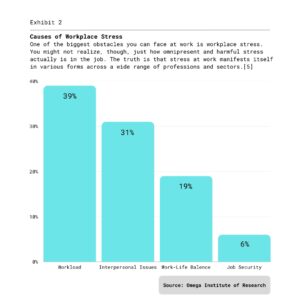- Industries
Industries
- Functions
Functions
- Insights
Insights
- Careers
Careers
- About Us
- Healthcare
- By Omega Team

Introduction
Workplaces today are dynamic and demanding, resulting in an increasing problem: workplace stress. Employees at all levels of an organization can be affected by stress, from entry-level workers to managers and executives. The purpose of this excerpt is to examine the sources, impacts, and potential solutions to overcome workplace stress in today’s fast-paced business environment.
How Stress Affects the Body
Stress can have significant effects on the body, both in the short and long term. In response to stress, a person’s body undergoes a series of physiological and biochemical changes. In response to threats or challenging situations, the body produces these responses as part of its “fight or flight” response. However, sustained or ongoing stress can result in a number of health problems. The body is impacted by stress in the following ways:
Nervous System: The sympathetic nervous system causes the release of stress hormones like cortisol and adrenaline when a person is under stress. The body gets ready for action as a result of a rise in heart rate, blood pressure, and breathing rate. Chronic stress can result in long-term alterations in the neurological system that disrupt memory, focus, and sleep patterns.
Immune System: Stress that lasts only a short while has the ability to temporarily strengthen the immune system. Chronic stress, however, can weaken the immune system, leaving people more prone to infections and illnesses.
Cardiovascular System: Stress can impact the cardiovascular system due to the rise in heart rate and blood pressure. This can eventually lead to the emergence of hypertension and heart disease.
Digestive System: Stress can cause digestive problems like indigestion, pains in the stomach, and changes in bowel patterns. Irritable bowel syndrome (IBS) and acid reflux are two illnesses that can be made worse by ongoing stress.
Musculoskeletal System: Stress can result in tight and tense muscles, which can contribute to headaches, back pain, and other musculoskeletal issues. Additionally, long-term stress can make fibromyalgia and tension headaches worse.
Respiratory System: Asthma and chronic obstructive pulmonary disease (COPD) are two respiratory disorders that stress can worsen.
Reproductive System: Chronic stress can alter hormone levels in both men and women, disrupting the menstrual cycle in women. Additionally, it might result in reduced libido and issues with conception.
Mental Health: Anxiety, despair, and burnout are just a few of the mental health conditions that are connected to persistent stress.
Skin: Acne, eczema, and psoriasis can get worse under the influence of stress.
It’s crucial to remember that different people react to stress in various ways, and not everyone will feel the same symptoms. Individual resiliency and coping skills can also affect how stress affects the body. The harmful effects of stress on the body and mind can be lessened by managing it through healthy lifestyle practices, relaxation techniques, exercise, social support, and seeking professional treatment when necessary.
Entry Level Stress
Entry-level jobs frequently have high demands, little autonomy, and little influence over how things get done. A few typical stressors are:
Job Insecurity: During economic downturns, entry-level workers may worry about the stability of their jobs and worry that they may be laid off or fired.
Monotonous Tasks: Tasks that are repetitive and boring can make people bored and demotivated, which can result in psychological anguish.
Low Pay and Benefits: When entry-level workers struggle to satisfy their fundamental needs, financial strain can lead to stress.
Lack of Career Growth: Feelings of Stagnation and Dissatisfaction may be exacerbated by a perception of a lack of prospects for progress.

Manager Stress
Managers are essential to any firm, but they also face a unique set of stressors:
Additional Responsibility: Managers are under tremendous strain since they must make decisions and are responsible for the success of their teams.
Managing Conflict: Dealing with interdepartmental problems or resolving arguments among team members can be emotionally taxing.
Time Restrictions: Managers frequently juggle numerous responsibilities and deadlines, which puts them under time pressure and causes stress.
Balancing Leadership and Friendships: Many managers may find it difficult to balance their friendships and leadership responsibilities.

Executive Stress
Despite holding the top positions within a firm, executives nonetheless experience stress.
Long Working Hours: Executives routinely put in long hours, which can cause weariness and a poor work-life balance.
Important Decisions: Executives must make crucial choices that could have a big impact on the company’s profitability and the livelihoods of its workers, which puts a lot of pressure on them.
Pressure from Board: Pressure from the board of directors and shareholders to achieve targets and maximize earnings can cause ongoing stress.
Isolation: Executives may not have peers with whom they can openly discuss problems, which can make being at the top isolated.
Impact of Workplace Stress
Stress at work can have serious repercussions, harming both individuals and the company as a whole:
Increased Absenteeism: High stress levels frequently result in an increase in sick days and absenteeism, which has an impact on team dynamics and workflow.
Higher Turnover: Talented workers may leave stressful workplaces in search of better possibilities, resulting in increased turnover rates.
Deteriorating Mental Health: Prolonged stress can cause anxiety, despair, and burnout, endangering the wellbeing of workers.
Reduced Productivity: Stress can affect cognitive function, which makes it harder to concentrate and be productive.
Solutions to Workplace Stress
Organizations can use a variety of ways to effectively treat workplace stress, including:
Promoting a Healthy Work-Life Balance: Develop flexible work schedules and give employees’ personal lives first priority to promote work-life balance and prevent burnout.
EAPs: Provide counseling services and support initiatives to assist staff in managing stress and issues with their mental health.
Supportive Leaders: Promote a positive workplace culture by encouraging managers and executives to be sympathetic and understanding.
Refined Communication and Feedback: Establish open lines of communication so that staff members may voice their issues and offer feedback.
Improved Training and Development: To inspire employees and increase workplace satisfaction, offer chances for skill development and career growth.
Conclusion
Stress at work is a complicated problem that has an impact on people at all organizational levels. Identifying the particular stressors that managers, executives, and entry-level employees face is crucial for creating focused solutions. Organizations can reduce workplace stress and promote a healthier and more effective staff by establishing a loving and supportive work environment.
Subscribe
Select topics and stay current with our latest insights
- Functions